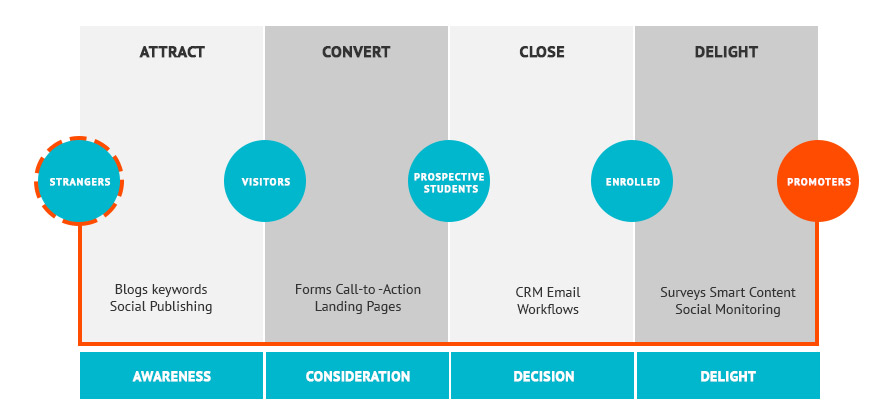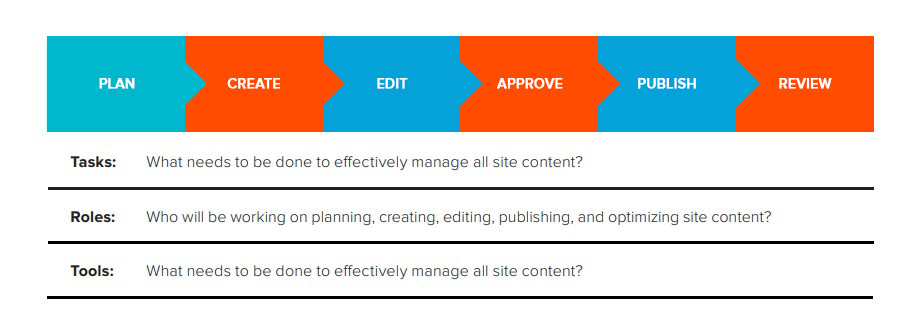Social… Blog…PR…Email…or anything else…what should I do? What content prospective students want to consume? What content parents want to consume? What content competitors are doing? What should we do?
Even some of the biggest marketing teams of a renowned B-Schools (that we have worked with) were struggling to find solution for these questions. And it is the case with the marketing teams of most of the higher ed institutions, specifically during admissions season.
One of the biggest blunders that most of the colleges do is spending their entire marketing budget during the admissions season.
You need a hair conditioner. You have been watching Loreal conditioner ads on TV since couple of months. Will you go with Loreal or choose a conditioner you have never heard of before?
Definitely, you will choose Loreal.
Same is the case with admissions marketing. Colleges tend to start their marketing activities when admissions season is on their heads. They haven’t built the up their lead funnels…They haven’t started their SEO activities…They have not fetched their prospective students and parents with the right content. And they expect students to turn up to their institution in numbers. Now, this looks like a fairy tale.
Building a brand recall value takes time. Branding activities must start at least 3 months prior to the admissions season. But most of the institutions tend to sleep during this period. This is the time to nurture the prospects and build their lead funnels.
Another mistake that higher education institutions is showing a wayside to their content marketing activities and never giving them any consideration.
The possibilities of high-quality, creative content on college websites are endless, but most of the higher education marketers don’t know how to identify these opportunities and where to start. Content is the breath of any inbound marketing strategy and can help institution drive prospective students their websites.
Content can help these students find the valuable information they are looking for, which in turn makes them see your college as the authority and perfect-fit for them.
Let’s break down what higher ed content marketing is, what it isn’t, and how institutions can develop a successful content marketing plan.
Content Marketing is best used to engage people when they are higher in the decision funnel, either to drive traffic to key destinations or reinforcing selected messaging. It builds awareness, motivate action, help audience understand what distinguishes and defines an institution and elevate the brand.
Content marketing tests marketer’s core competencies and insight, bundles it in way that resonates with target personas, and enables its discovery. The content may be a YouTube video, blog, social media post, or even a newsletter.
Content marketing can be amplified with advertising, or organic SEO, depending on strategy and budget. Developing it right is the goal of every higher ed institution.
But before we move to developing a content marketing strategy, let us first learn why colleges and universities need a content strategy.
Institutions have plenty of content sources, but they need to start utilizing them. School magazines, alumni notes, student highlights, website, newsletters, and there are endless sources to push content.
Content strategy helps to ensure that the content is written on brand, using targeted messaging and right tone, and is tailored for the right audience. It drives the institution towards creating a valuable content repository that attracts, engages, and delights the perspective students.
The goals of a successful higher education content marketing strategy are to:
Building a content marketing strategy is a detailed process that might look overwhelming to the even the biggest marketing teams responsible for driving digital presence.
Here is how institutions can create a great content marketing strategy that effectively engages your target audience and delivers results:
Colleges have to do some ground work to develop their content strategy and it starts with research. Start building the research gameplan with internal stakeholders. It will help learn everything about the target audience.
Stakeholder Interviews
Such type of interviews helps in prioritizing the institutional goals, understanding key differentiators, and define what role the website will play in institutions’ strategy for admissions marketing.
Meetings with Admissions Team
It provides content marketers an opportunity to sit down with the admissions team and discuss all the assumptions that marketers may have related to the target audience and their needs. The goal of such sessions is to understand target personas and build strategies to engage people on your website.
User Surveys
Conducting a survey of your website users is really important. Knowing who is visiting your website, what resources they are finding useful, and what compels them to leave their information. To ensure that the survey results are unbiased, it’s better to collect responses through your website rather than sending emails.
Website Audit and Analytics
Conducting website content audit and traffic review is another important step to determine what’s working and what’s not. Include following in the audit process:
The hard work is done. It’s time to reap fruits. You are now ready to build user personas and map content to each type of persona as they traverse through the applicant journey.
Create a Detailed User Persona
User personas were believed to be fictional. But research-driven representation of a single user represents a key user group of your website. Based on your research, find out your ideal customer profile. You can create a content strategy for each type of persona. User personas are useful to:
Determine Content Positioning and Messaging
To establish credibility, your content must support the articulated brand hierarchy. Your brand hierarchy is made up from three constituents-
These three constituents make up the brand hierarchy. It helps you to set the brand communication and identify the right messaging.
Map Content to the Needs of Your User Personas
After crafting your user personas and identifying the content messaging, it’s important to plan how this content will address each stage in their journey.

You are now all set. You have built a successful content marketing strategy. But don’t go out for a round of drinks. To make sure that your content strategy will be successful in a long haul, you need a content marketing plan in place. Your content marketing plan will identify who will be in charge of each task in the plan.
Content Governance
It describes how to manage the digital content in a controlled manner. With a right governance model, even a small team with an average budget can support a high-quality and consistently delivered content marketing plan.
The content governance model must provide a practical framework to carry out your content strategy. Content workflows must be created to align tasks to the respective stakeholders.

Start with a simple editorial calendar targeting each audience persona. The content must be reviewed with traffic it is generating. You should also determine what is working and what needs to be adjusted according to the content performance.
Recheck Personas and Content
Institutions evolve over the time. It is important to stay ahead of the curve. You should check your users at least once in a year through surveys, events, or meetings. Based on the feedback, you can adjust the content strategy based on the changing needs.
You have done all the hard work in researching and creating the content strategy. It’s the high time to bring your editorial calendar to life. Reach out to each stakeholder responsible for completing the tasks and give them strict deadlines.
Your approach to your institution’s content marketing strategy will be your recipe for success. Spend some time in perfecting your strategy to increase engagement with your target personas. Start it right and get ready to boost enrolments during the admissions season.